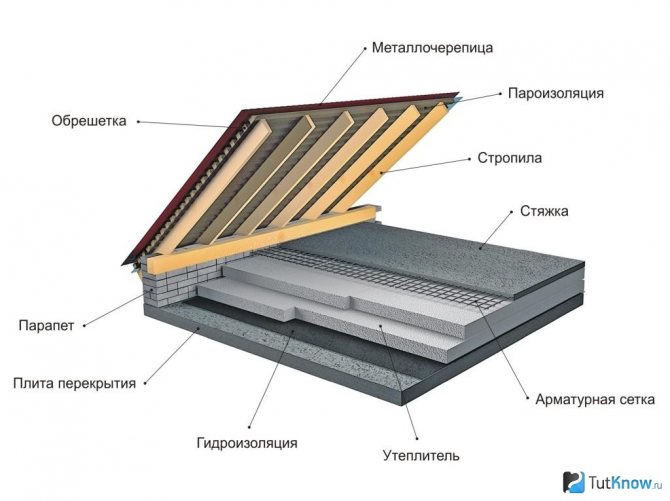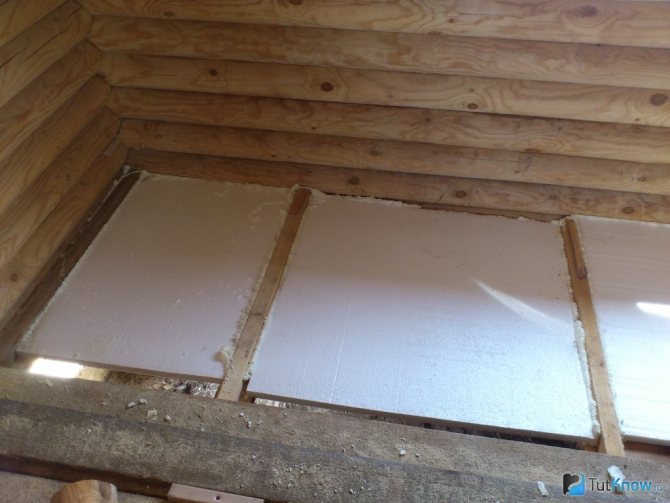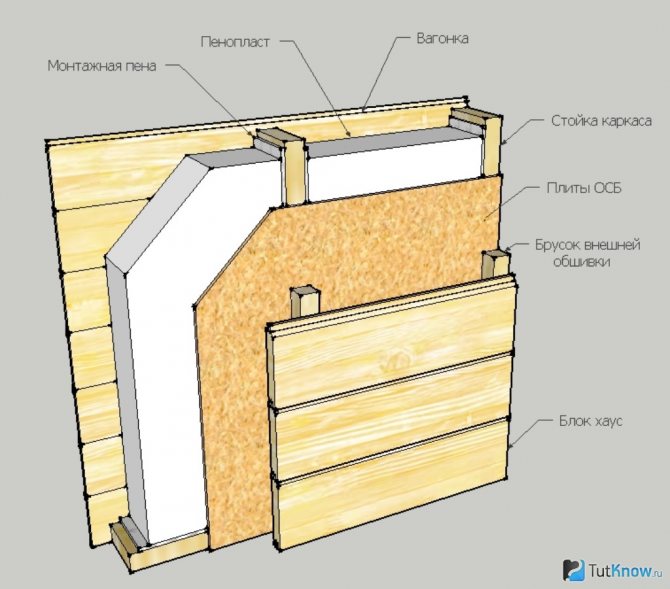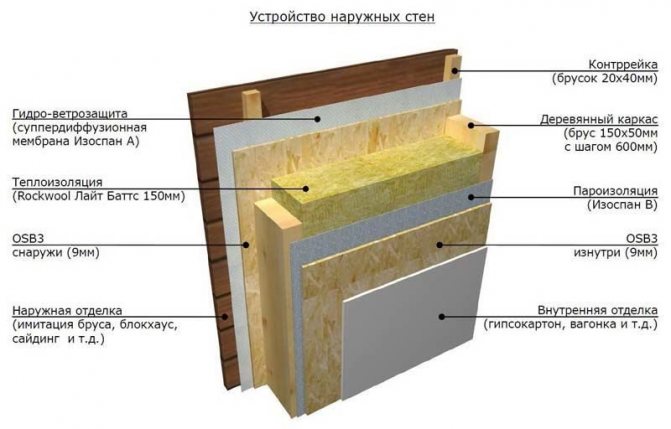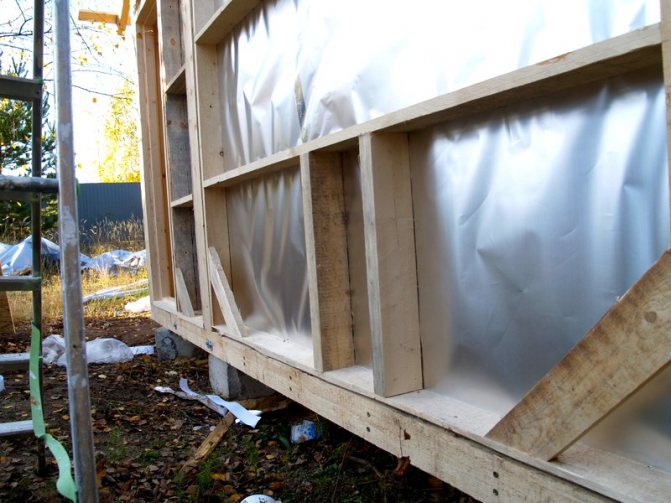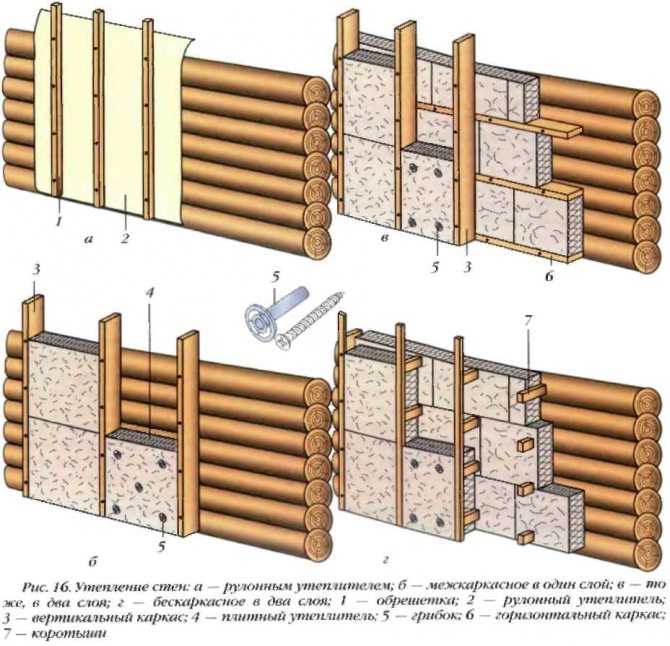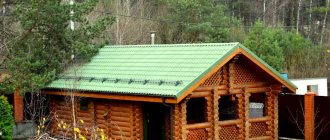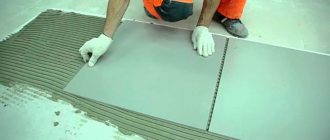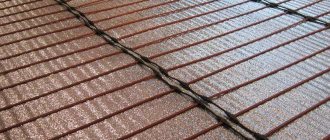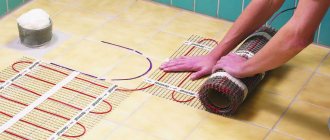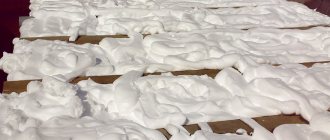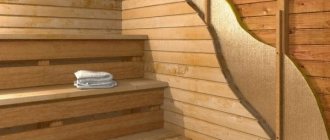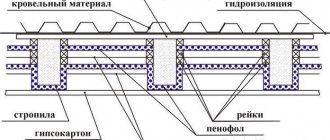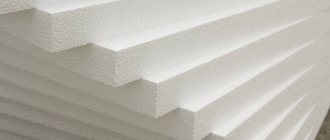Steam room, washing or dressing room
Steam room insulation
The steam room is the room with the highest temperature. In the Russian bath, 60-90 degrees are optimal, in the Finnish - 70-110. In addition, the baths are often burned down. This means that the materials used in the construction should:
- withstand this temperature (and humidity);
- do not emit toxic substances when heated;
- do not sustain combustion.
The limitations are significant. The types of insulation will be discussed below, but it is already clear that the choice is extremely limited.
If an environmentally friendly insulation strongly gains moisture (while losing its properties), you also have to take care of its high-quality insulation between the layers of the hydro and vapor barrier. And in order to prevent rotting of the tree, which is most often used to finish the steam room, it is necessary to leave ventilation gaps between the vapor barrier and the same clapboard or imitation of timber.
From what has been said it is already clear that the steam room is insulated from the inside. The ceiling part requires special attention, because light steam tends upward to the ceiling, where the main heat loss occurs in the absence or improper insulation. The vapor barrier is laid in two layers.
Foil is often used as it in the steam room, because it is capable of reflecting infrared radiation and returning it to the room (like in a thermos). In addition, it is an excellent vapor barrier because it does not allow water to pass through at all.
Another problematic place is the outlet of the stove chimney. It must be properly insulated and the ceiling must be protected from overheating. A high threshold to the steam room and a low, but wide door will help to keep warm.
Insulation of the washing
Insulation of walls in a washing room in a bath. The washing room differs from the steam room in that the temperatures are lower and the humidity is higher. Nevertheless, the problem of saving heat is also relevant for soap. Insulation methods are no different from a steam room, except that there is no need for a double vapor barrier.
But there is a need for good ventilation. The floor in the sink is often made of tiles. If desired, it is insulated with a "warm floor" system. Less steam accumulates under the ceiling than in the steam room, but there is no need to leave space for heat loss here, so the ceiling of the washing room is also carefully insulated.
The dressing room, although it is not directly exposed to steam and water, still refers to rooms with high humidity - the proximity to the steam room and the washing room affects. Therefore, all recommendations regarding the choice of heaters and the need for insulation apply to it.
The dressing room also needs insulation so that it does not become the refrigerator that will take heat from other rooms. The scheme of an ordinary pie may not be needed if you use polyurethane foam as insulation in the dressing room - it does not need to be fixed to the wall and insulated from moisture and steam.
Do-it-yourself steam room floor insulation
Consider two options for thermal insulation of the floor in the steam room - using polystyrene and perlite. Perlite is sand produced (expanded) at an enterprise using a special technology.
Thermal insulation of the floor in the steam room with a screed
Expanded polystyrene meets the requirements for steam room thermal insulation. This is an environmentally friendly insulation, gives a minimum load on the foundation, does not absorb moisture, is not afraid of insects and rodents, there is practically no waste during work, but the insulation can only be laid on a pre-leveled base.
Polystyrene insulation technology:
the first layer is waterproofing; the second layer - polystyrene foam plates; the third layer is a reinforcing mesh; the fourth layer is a concrete screed.
Perlite floor insulation technology:
1.mix perlite with water in a ratio of 2 to 1; 2. add cement to the resulting mixture and mix; 3. additionally add half a liter of water and one bucket of perlite; 4. stir the mixture until water appears; 5. Pour concrete with the first layer, with the second layer a thin layer of our mixture; 6. After a week, the concrete screed can be applied (third layer).
In the first and in the second case, the floor can be tiled, porcelain stoneware, a traditional wooden floor can be laid, which will be more pleasant and warm for the feet in the steam room. See further video instructions on how to insulate a steam room in a bath independently from the manufacturer of thermal insulation.
What are the advantages of the frame structure
The device of the inner part of the wall of the frame bath.
- The frame structure will turn out to be about half the price compared to a sauna built from logs. Savings arise not only due to the use of inexpensive materials, but also when choosing a simpler type of foundation. There are significant savings in time and labor. For example, to build a frame bath with your own hands in the warm season, it will take several weeks and one or two assistants to make it more convenient to conduct the work process.
- The construction will not shrink, therefore, the bath is finished immediately after the completion of the construction process, so you will not have to postpone the use of the bath for its intended purpose for a year, or even more.
- Insulation of a frame-type bathhouse allows you to end up with a room that resembles a thermos, which can retain heat for a long time, since there is not a single gap through which the wind would pass.
- The modern materials used to insulate the bath are highly resistant to fire (they will not catch fire), so the likelihood of occurrence is significantly reduced.
- Excellent thermal insulation can significantly reduce the heating time of the bath. It takes only two to three hours for the bath to warm up entirely. This is very little, because it will take at least twice as long to warm up a wooden bath. Hence, we can conclude that there is also savings in firewood for kindling, during the year a large percentage of saved firewood will be obtained.
- The frame structure allows the use of external cladding, which makes it possible to give the bath a unique look, to distinguish it among the buildings, or, conversely, to fit into the style of other adjacent buildings.
Thermal insulation of the bath roof with foam
You can use foam as insulation over the steam room only in the second layer: if a layer of clay is applied to the ceiling, expanded clay is poured or mineral wool is laid, the foam plastic can become the next layer of the cake. But in this situation, it is necessary to make the ceiling vapor protection very high quality, otherwise the vapor will "get stuck" in the lower layer of thermal insulation.
We offer you to familiarize yourself with: Finishing a brick oven
In order to clearly demonstrate how effective the foam is in comparison with other materials, we found the following data: foam with a thickness of 6 cm in terms of thermal insulation properties replaces:
- mineral wool 11cm thick;
- tree - 19.5cm;
- dry foam concrete - 50cm;
- brick wall 85cm;
- concrete 213.2cm.
Impressive. It is so? But for thermal insulation of a bath, foam plastic should be used either for external insulation of walls and facades or for insulation of premises without high temperatures. Please note that under the ceiling in the washing compartment, the temperature often reaches 90 ° C, which is almost critical for foam.
What kind of bath, wall insulation from the inside or outside?
A question that torments many bath owners when they think about insulating it. In fact, everything is not as complicated as it seems. If you are already familiar with the concept of "dew point", then for a bath it is not very relevant - this is a room that is used from time to time, and when used, the temperature and humidity jump sharply and high. Because of this, the dew point slides back and forth when you heat the bath, splash water on the stove when it cools down and ventilates.
Therefore, the main task of the owner is to create proper ventilation in the bath and thoroughly dry the premises after the bath procedure. And it is also worth putting insulation that does not deteriorate from dampness and dries out easily.
At least first of all, the insulation is installed from the inside, because by insulating from this side, you will not spend energy every time on heating the entire thickness of the walls, which have cooled down to the outside temperature in winter since the last visit.
And when they are insulated from the outside, they end up inside the "pie". And no matter what kind of walls we are talking about - they all cool in the cold. If the internal insulation is not enough, then you can take on the external one, with one condition: you need to leave a gap between the waterproofing and the cladding in order to get a ventilated facade.
IMPORTANT! For external cladding, it is better to use a membrane as waterproofing that will release vapors from the insulation, but prevent the penetration of street moisture.
In addition, there is a specificity in the material of the walls: block baths, due to the hygroscopicity of the blocks, need external cladding, it is almost always combined with insulation from the outside. But wooden baths are not insulated from the outside, for fear of decay of the walls.
The warmer the bathhouse itself, the less firewood will be consumed to heat it and the longer it will retain heat. In general, bath insulation is a complex process. And the rest room, steam room and dressing room can be insulated in completely different ways: due to their constant microclimate. So how to properly insulate the bath? Let's figure it out.
So, how to insulate a bath from the inside, depending on what material it was built from.
We insulate the walls, ceiling and floor in the steam room from the inside
How to insulate a steam room in a bath?
Regardless of the material of the walls, the ceiling with the steam room floor (brick, timber or concrete), the main insulating element is the interior decoration with insulation (mineral wool + 1 cm lining). This does not mean that a wall made of timber is not capable of being insulated. It will take more time and heat to heat a steam room from a bar or brick to the required temperature, since you will have to heat wood or brick at the same time. A steam room of optimal dimensions from a bar of 15 cm will require 120 kWh. heat to heat up to 100 degrees at the ceiling. With an additional layer of insulation 4 cm and lining 1 cm, the heat demand will become 15 kW. hour. The climatic comfort in the steam bath depends almost entirely on the steam in the steam room.
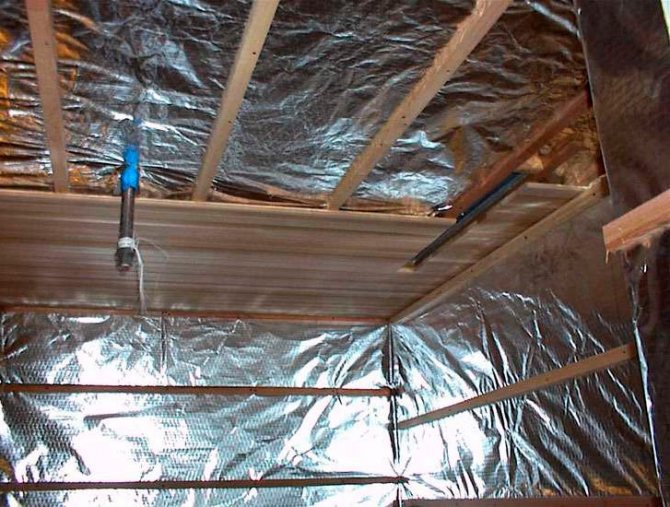
The main heat-insulating material for the steam room will be a material with thermal conductivity parameters up to 0.5 x 10 (-4) kW / m x deg.
It is necessary to raise the clean floor to + 0.150 and the thresholds of the entrance door to + 0.350.
Warming the floor in the steam room
To ensure the required rate of thermal conductivity of the enclosing structures of the bath, it is required to reduce heat loss through the floor of the steam room. The steam room is the most heated part of the building; therefore, the floor must be insulated in the steam room. Considering that in winter the ground freezes to a depth of 1 m, therefore, the better we insulate the floor, the less losses will be. Under the entire steam room, we drip a hole up to 60 cm deep from the level of the clean floor. Having leveled the soil in the pit, we perform sand preparation of the base 5 cm thick. On the finished base we arrange the main layer of foam insulation 20 cm thick. Treat the joints between the sheets with mounting foam or foam glue. We carry out two layers of 5 cm each from cement mortar mixed with foam plastic chips and vermiculite (50:50).
After the base solution has hardened, pour concrete reinforced with a 10 x 10 cm mesh, grade M 200, 25 cm thick, with iron (on the second day of hardening, the surface is sprinkled with a very thin even layer of dry cement M500) of the upper surface with a slope towards the sewer riser.
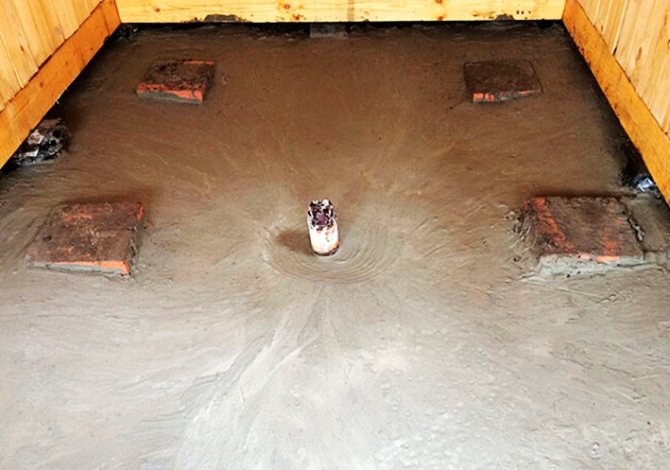

After the solution has hardened, fill the base with concrete
After completing all construction work (but not earlier than two weeks later), we lay the plank floors. For non-leaking floors, use a floorboard with a quarter total slope towards the drain.Leaking floors are made of a floorboard with slots. Consideration should be given to removing the floorboards to dry in the sun.
In existing baths, floors can be of different designs. The most common in the steam room are leaking floors on the ground or in a ventilated concrete funnel (ladder). It is necessary to decide how and with what material you can insulate the leaking floor in the steam room. Do-it-yourself insulation option is to make a concrete floor made of M200 concrete 25 cm thick with foam insulation 20 cm thick.Or a claydite concrete floor with a masonry reinforcing mesh 100 x 100 mm. Old sand must be replaced as it is not capable of supporting the floor. After completing the concrete work, lay a plank non-leaking floor with water drainage into the sewer (as shown in the photo).
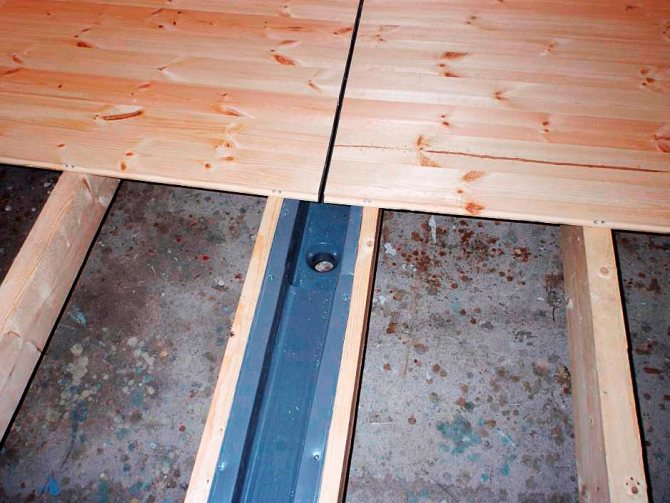

Plank floor with water discharge into the sewer
For a leaking floor, iron the concrete surface with a slope device to the sewer.
Thermal insulation of ceilings in the steam room
The construction of modern baths and saunas is carried out using reinforced concrete floor slabs. The thermal conductivity of the slabs is not low enough for a steam room. Therefore, additional thermal insulation is required to create a comfortable temperature. Bars 10 x 10 cm are attached to the slab along the entire length with a step of 50 cm from each other on dowels. The bars should press the glass cloth or vapor barrier film against the bottom surface of the slab, which prevents the accumulation of condensation at the joints of the thermal insulation of the walls with the ceiling in the steam room. The extreme bars around the perimeter of the steam room should press the fiberglass against the walls.
Basalt or kaolin wool 10 cm thick is laid between the bars. The lining 1 cm thick with nails with flattened heads presses the main vapor barrier layer of foil. In the attic, a vapor barrier film + expanded clay thermal insulation 15 cm thick is additionally arranged.
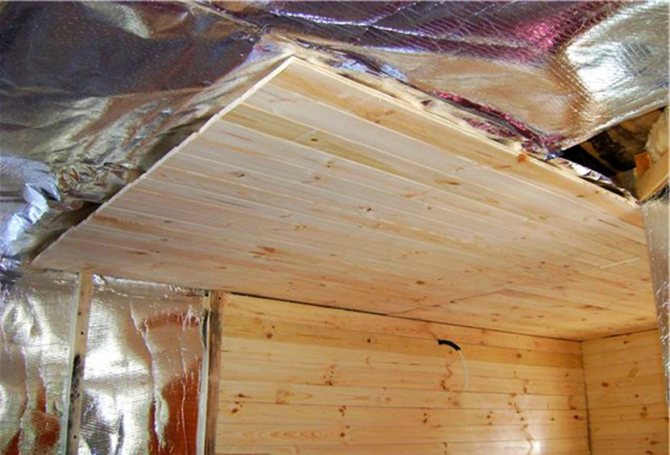

The photo shows the order of the layers of thermal insulation of the ceiling in the bath
Insulation of the walls of the steam room
The walls of the steam room are insulated in the same way as for floor slabs. When insulated, walls made of timber (log house) require the use of special structural elements. Before properly insulating the walls of the bath in the steam room from the inside, you need to know what kind of deformation occurs with the timber when the temperature and humidity change during two years of operation. To compensate for linear expansions, it is required to provide sliding fastening supports between the wall material and the material of the insulation structure. The better such supports work, the fewer gaps in the timber wall will be. If all the walls of the bath are made of timber, then it is necessary to provide for a shrinkage of 20 cm when installing insulation and inserting door and window openings not only in the steam room, but also in the washing room with a changing room.


Lathing option
In vertical bars 6 x 6 cm of lathing for lining after 50 cm, vertical grooves 20 cm long for nails are made. Bearing lathing bars with grooves are made vertically every 50 cm. Nails through the slots in the bars are nailed to the wall from the bar, pressing the vapor barrier film, which prevents the accumulation of condensate at the joints of the wall insulation with the ceiling in the steam room. The nails are positioned based on the possible shrinkage or swelling of the timber in the middle of the groove when insulating the steam room. And for the rest of the walls above the middle of the groove. Do I need to complicate so much
insulation design? Yes need. This allows you to prevent the log from hanging on the nails of the sheathing after moving it in the grooves of the sheathing, which increases heat loss.
The nails move when they shrink and come back after swelling with moisture. The maximum travel length (20 cm) is under the ceiling. The insulation is cut to size. It should fit snugly against the battens of the sheathing. It is not recommended to use polyurethane foam in the steam room. Vapor barrier sheets (penofol) are attached with a furniture stapler to the lathing bars.The surface covered with foil should be directed towards the interior of the room. Close the joints with aluminum tape. To create an air gap between the vapor barrier and the lining, a counter-lattice of 2 cm thick bars is used.
Wall cake of frame bath
Floor covering device.
Very often, when we talk about a wall, a picture of brickwork appears in our head, but nowadays a wall is not just stacked bricks or concrete, but a very complex, multi-layer structure.
The wall can be made in several layers, each of which will consist of a certain building material, combining insulation, bricks and other materials necessary for the work.
An example of a properly made cake would be the following combination of layers:
- A bar with a minimum thickness of 150x50 for the frame.
- Mineral insulation, which will be located between the frame posts (you can use rolls or mats of mineral wool).
- OSB board with a minimum thickness of 15 mm.
- The lathing is horizontal.
- Insulation required for horizontal lathing.
- Vapor barrier (or wind barrier), it is permissible to use a multifunctional membrane.
- The lathing is vertical type.
- External finishing.
- Vapor barrier material.
- Lining (or drywall) for interior decoration.
Stages of warming the bath outside.
The outer covering must be laid on the crate to create a ventilation gap (condensation will evaporate and not accumulate). It is unacceptable to place the external finish directly on the membrane in order to prevent the insulation from sticking to the finish and its subsidence.
After the frame has been erected, it is necessary to carry out interior decoration using boards with a thickness of about 2-3 centimeters. It is best to use wood that will not rot in high humidity, such as linden, aspen, larch. The selected sheets are nailed to the vertical beams. For the decoration of a very part, a wooden lining is used, which also helps to strengthen the entire structure, and not only creates a pleasant appearance.
As a vapor barrier material, it is allowed to use a special film or parchment. The film is placed with foil to the side of the room so that it warms up faster. This material is simply necessary for a frame-type bath in order to avoid moisture or condensation from entering the internal walls.
Insulation is applied to the vapor barrier to ensure the required level of thermal insulation. The waterproofing is attached directly to the beams. Next, the external walls are sheathed using DSP or OSB sheets, attaching them to the beams. The outer walls of the bath are sheathed with lining, siding, block house, boards to give the structure a proper look.
An example of a floor device in a frame bath: ecowool + cable floor heating system
The floor in the bath must be warm, not subject to decay, and not absorb water. Such a floor is not difficult to make in a log house. And what to do if you have a frame bath? After many days of deliberation, it was decided that in my frame (6x4.5 m) the floor will be multi-layer, with an OSB roll and an electric floor heating system introduced. This will make the surface comfortable, speed up its drying between treatments. In the place where the stove is installed on the floor, for even distribution of the load, it is necessary to install a concrete support slab.
I will describe the whole process of installing such a floor. By the beginning of construction there were: a columnar foundation and a wooden grillage on it.
- 3 Arrangement of a concrete slab under the oven
- 4 Installation of underfloor heating system
- 5 Cladding with floor tiles
Installation of the floor log
First of all, a frame with internal bridges-lags was hammered from 150x50 boards. The spacing of the beams, along the long side of the frame, was 400 mm. Additional beams are installed along the perimeter of the future slab.


The device of the log of the floor of the frame bath
Floor slab device
Floor pie scheme (bottom-up):
- subfloor roll - OSB-3 (thickness 6mm);
- waterproofing and wind protection - "Izospan A"
- insulation - ecowool
- OSB-3 shield (18 mm thick);
- insulation - EPS, 5 cm;
- vapor barrier - "Izospan D";
- reinforcing mesh;
- underfloor heating cables;
- screed;
- tile adhesive;
- tile.
Now more about each layer.
Step # 1 - roll up the subfloor
OSB-3 sheets with a thickness of 6 mm were nailed from the lower side of the log. Drainage holes are drilled on them for ventilation. Also cut a hole for the drain outlet.
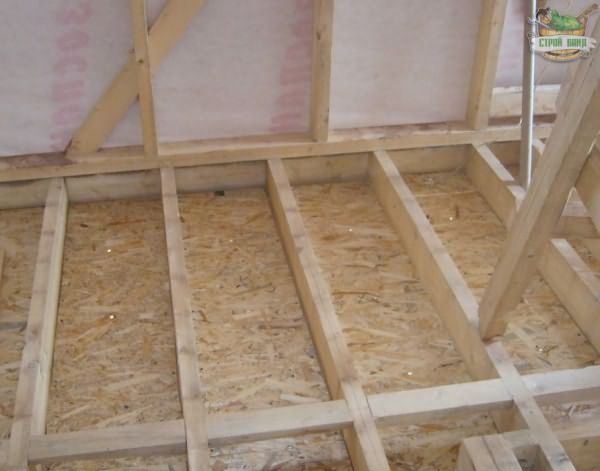

Installation of a sub-floor from OSB-3 sheets
Step # 2 - waterproofing the floor
Waterproofing and windproof film "Izospan A" was laid on the roll. All joints were glued with construction tape.
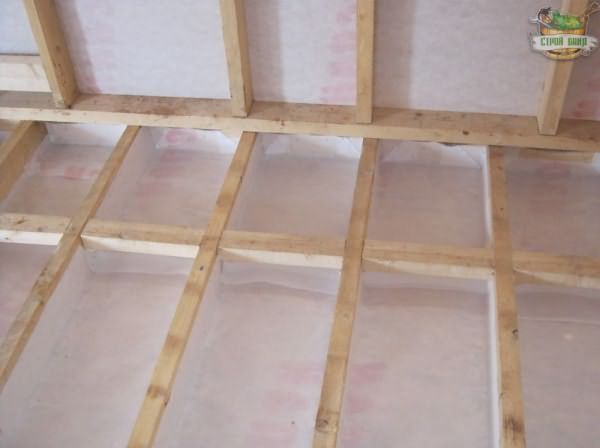

Waterproofing the subfloor roll with Izospan A film
According to the plan, the inlet ventilation hole in the bath will pass under the stove. To organize it, a metal box from the hood was installed between the lags. A drain tee is also installed.
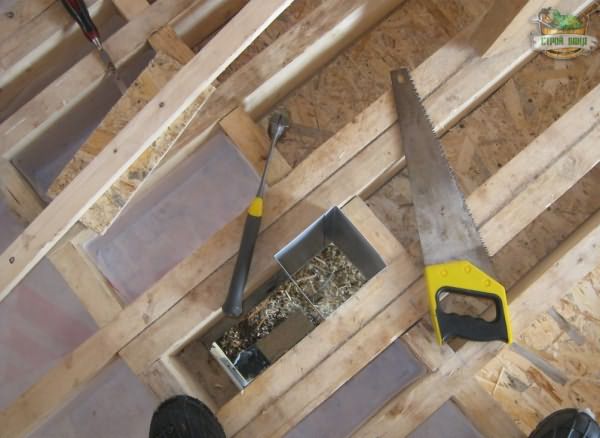

Installation of the air inlet box
Step # 3 - insulation with ecowool
The first layer of insulation is ecowool. But since niches were formed in the ceiling between the lags and the lower trim of the walls (where it is difficult to deliver ecowool), they were filled with Rockwool insulation.
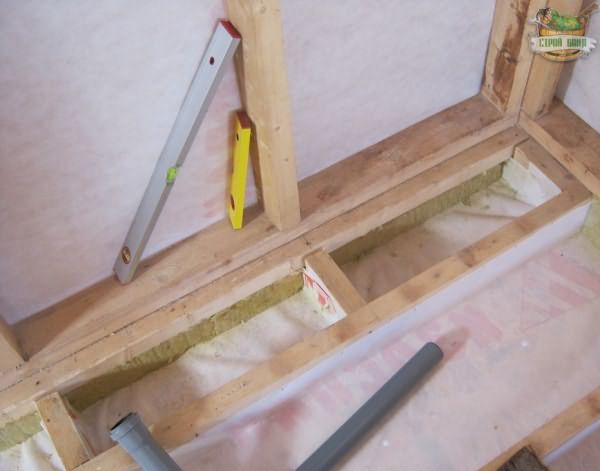

Insulation "Rockwool" is laid in niches under the wall trim
I beat the ecowool with an electric drill. In the process, the material has increased approximately 2.5-3 times from the initial volume. The fluffed insulation was laid manually between the logs, on the waterproofing. The surface was compacted and leveled with the rule flush with the lags. At this stage, the organization of the drain is completed.
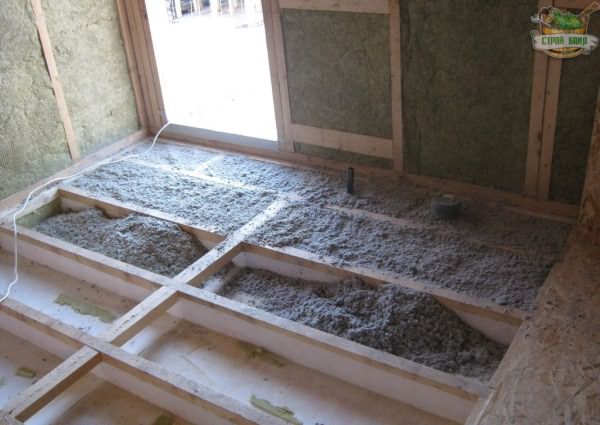

Laying ecowool between floor joists
Step # 4 - OSB-3 cladding
Then the ecowool was covered with another layer of OSB-3. The sheets were cut into pieces so that their edges were located on the logs. Wooden mortgages are also fixed between the logs and the lower trim of the wall frame, which serve as supports for OSB-3.
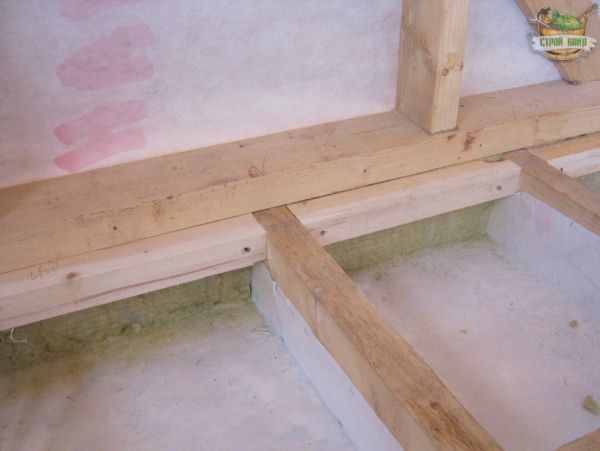

Embedded timber for OSB-3 support
Taking into account possible expansion (swelling), OSB-3 was laid with a small gap of 2-3 mm. They were fixed - with self-tapping screws to the lags.
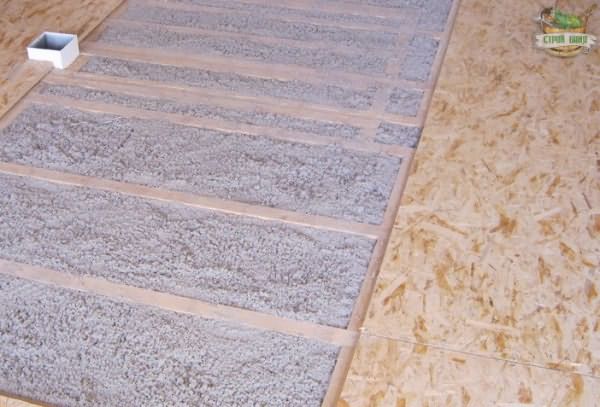

Sheathing lag sheets OSB-3
Step # 5 - insulation with EPS boards
The next step is additional insulation of the floor with a layer of EPS (extruded polystyrene foam). The slabs were laid apart. To do this, whole slabs had to be cut with a construction knife (whoever has a jigsaw, it is better to use it).
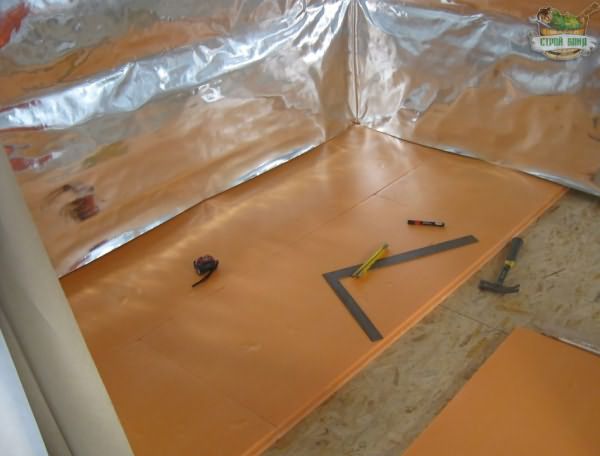

Floor insulation with EPS sheets
The drain was waterproofed. Around the drain on double-sided tape "Izospan D" is glued, the joints between the pipe and the film are filled with sealant.
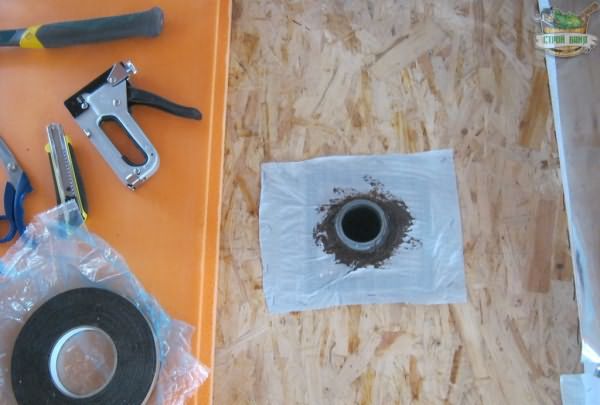

Drainage waterproofing with Izospan film and sealant
A place was left for the installation of a concrete slab under the furnace.


In the place where it is planned to pour a concrete slab under the furnace, the EPS does not fit
Vapor barrier
The importance of vapor barrier is to prevent water vapor from wetting the insulation, which therefore loses its thermal insulation properties.
In the case of foil, the task becomes more complicated: it not only does not allow steam to pass through, but also must reflect most of the infrared radiation. More information about foil can be obtained from the link given above, where we considered the thermal insulation of the steam room.
The physical properties of the material used as a vapor barrier should not change with strong heating.
It also includes the requirements for environmental friendliness for insulation.
Bath wall construction with vapor barrier.
Experienced builders advise using a 50 mm thick roll Ursa for wall insulation. It is laid between the uprights, located vertically, with alternately nailing the rails to them. In some places, nailing directly to the outer boards is allowed, but this can only be done with the help of special nails, which have a rubber washer under the head.
The negative for a frame bath is the formation of moisture in winter, when it is hot in the bath. It is for such moments that a vapor barrier is needed. At the moment, the best option is a plastic wrap, which should be placed under the inner lining.
It is important to note that a high-quality vapor barrier lining is required for the steam room. A good example of this type of vapor barrier is aluminum foil, vapor barrier film, glassine and other materials. For this room, it is undesirable to use roofing material or roofing felt because of the specific smell that will be released when heated.
Thus, a wall cake is obtained, consisting of the following layers:
- outer lining layer;
- glassine layer;
- insulation layer;
- a layer of plastic film;
- inner lining layer.
It is very important that a small gap of 5 cm is formed inside the wall.
Ceiling insulation
Work begins with leveling the ceiling, sealing seams, irregularities and chips with putty and priming the working surface.
Then the insulation plates are either fastened upward with the help of metal suspensions, or a crate is made of a metal profile, to which the penoplex is already attached along the assembly seams. All seams and joints (in both versions) are blown out with polyurethane foam.
When the insulation is ready, it is necessary to reinforce the surface with fiberglass mesh, and finally carry out finishing work.
Thermal insulation of walls in the bath and their decoration
The "pie" scheme is similar both inside and outside: if a non-sprayed insulation is used, then
- the first layer to the wall is the crate;
- followed by a layer of insulation;
- then a layer of vapor barrier;
- ventilation gap (for example, using lathing);
- external or internal wall decoration
Since we are talking about baths, the majority, of course, prefer wood. If not in the whole bath, then at least in the steam room. This could be:
- lining;
- imitation of a bar;
- block house.
It is optimal to use larch or aspen in the steam room, but it is better to leave conifers for the washing room - in the steam room they can cause a burn, and in the washing resin it will protect the tree from decay if moisture gets too much. However, in washing rooms, tiles are often used for interior decoration - ceramic, made of natural or artificial stone, porcelain stoneware. There is also a cheap option with plastic panels, but I don't want to recommend it - because of the smell.
It does not matter that a frame sauna will be an inexpensive option for a bath, it can be given a very expensive and exclusive appearance, and it is not necessary to do with simple painting of the walls. Thanks to the large number of modern building materials, you can give the walls of the bath a decent appearance. The walls from the outside can be finished with thermal panels, facing bricks, vinyl siding, block houses.
Here, the imagination of the master is important, who can make a beautiful and functional room from the frame version of the bath.
Why does the bathhouse need insulation?
The bathhouse needs insulation like no other room. The greater the difference between the temperatures inside and outside the building, the greater the loss of thermal energy (the more often you run after firewood and release steam).
For comparison: the temperature difference in Moscow between an apartment and a street is only 50 degrees in winter.
For insulation of the bath, it is preferable to choose the material penoplex. Read more about choosing penoplex in this article.
Penoplex is a modern building material used to insulate almost all (except for high-temperature) parts of a building, starting with the foundation and basement, continuing with the walls inside and the facade and ending with the attic and the roof.
Penoplex is a close relative of polystyrene, but it is made using a different technology, and its physical, mechanical and chemical qualities are much higher than the same qualities of polystyrene.
In terms of strength, penoplex exceeds polystyrene, which is especially important for insulating the facade and floor. In terms of thermal conductivity, too - the lower the thermal conductivity, the better the temperature is maintained, and this quality in our case is simply key. In terms of temperature, they are equal, but penoplex loses in terms of water absorption, but you do not need to be afraid of the figure of 0.4% per day, because in 28 days this indicator increases to only 0.5%!
Take note: for wet rooms, the manufacturer recommends choosing "Penoplex-Comfort" - this is a universal brand that is not susceptible to fungal infection. It differs from other brands of this insulation only by a slightly lower strength and reduced water absorption.
Wall construction rules and procedure
A frame wall in a bathhouse has many advantages. So, for example, these include its lightness, ease of installation and a relatively low price. But a rather serious disadvantage of buildings erected from such walls is the fact that they do not keep heat well. It is possible to correct such a defect by carrying out additional insulation of such walls.
The wall cake in a frame bath consists of vertical racks fastened with various fasteners, as well as various finishing materials and heat insulators. At the same time, the structure diagram of such a wall should, in any case, remain unchanged. So, in particular, a vapor barrier must be installed inside such a wall. Only after its installation is the insulation for the frame bath mounted on the walls, which is closed, in turn, with a finishing material.
The main task of vapor barrier in such a structure is to protect the wooden elements of the building from the effects of excess moisture.
The vapor barrier installed for this purpose allows you to protect the bath from rot and distribute the effect of moisture on it, evenly creating a special microclimate under the insulation.
If you are just building a frame bath, then wall insulation should become one of the most important operations in its construction. The fact is that only a properly assembled "sandwich" will allow the frame wall to reliably protect the premises from wind and heat loss. If you make a mistake in the process of insulating your bath, it will remain cold even if you heat it well.
As for the device of the described wall, the frame bath has a kind of wall cake, which includes:
- inner lining;
- vapor barrier;
- crate;
- insulation;
- specialized membrane layer;
- external cladding.
In this case, the thickness of the walls of the frame bath in this cake is a determining parameter. Due to the fact that recently insulation materials have been created that work much more efficiently, this parameter tends to be reduced, but earlier the builder tried to make such a wall as thick as possible in order for it to better keep heat in the interior of the building.
For a building such as a frame bath, the wall thickness should be at least 18-20 cm.
In this case, the specific value of this parameter may vary depending on the insulation material used in the construction process. At the same time, unlike a brick wall, the frame wall practically does not change its weight when using a thicker insulation, which allows the use of a light strip type of foundation during construction.
When erecting the walls of a frame bath with your own hands, you should seriously think about how exactly you will insulate it. The fact is that each of the layers described above plays its own special role in the process of preserving heat, therefore there are nuances in the installation of each of them, which must be taken into account in the production of finishing and construction work.
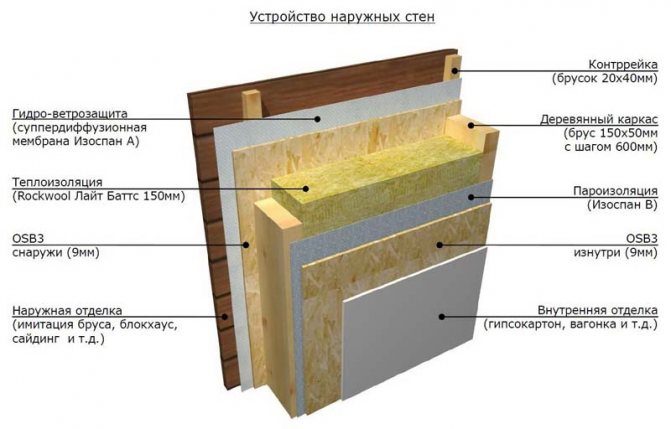

So, for example, frame walls, as well as insulation and vapor barrier of a bath can be carried out in two different ways: inside and outside. The best option is a combination of these two methods, since in this case the wall will be protected both from the inside and from the outside.In the same case, when you live in a relatively warm area, it will be more complete to insulate your building from the inside.
From a technical point of view, the installation of insulation does not present any particular difficulties, since almost all types of modern heat insulators are produced ready-made, and you just have to install them in place using the instructions supplied with the insulation kit. If you use old methods of insulation, for example, with the help of shavings or slag, you will separately have to clarify how to insulate the walls in a frame bath with their help.
In addition, it is worth separately learning how to build the floor and walls of a frame bath. The fact is that it is best to insulate the same floor during the construction of the building, and not to open it for additional work on the installation of thermal insulation. Usually, the floor is insulated with the same materials as the entire structure, for example, mineral wool, but expanded clay can also be used for this, pouring it under the floor boards in the space between the logs.
Separately, it is worth mentioning this type of bath insulation, as underfloor heating. It is carried out by installing heating elements powered by electricity, or using the energy given off by hot water. In this case, you will have to equip the floor in your bath using a separate technology, but as a result you will be able to regulate the heat level of your floor, and also provide the building with additional heating options.
Before installing a heater in a frame bath, experienced builders recommend carrying out electrical wiring and arranging other utilities.
The fact is that it is not recommended to open the frame walls several times, as this negatively affects their durability. It will be optimal when you perform all the necessary operations only once, while hiding all the wires and pipelines in a non-combustible and moisture-proof box.
The effectiveness of the insulation of frame structures directly depends on the choice of the type of insulation material. At the same time, any heat insulator in a bath must be able to withstand high temperatures with a significant level of humidity. It is also imperative to pay attention to the fact that the material used as insulation does not emit toxic substances when heated.
Modern heaters are natural and artificial. Artificial ones are the most common because of their high technical characteristics and low cost. Natural environmentally friendly ones can be used in the process of warming a traditional Russian bath or a Finnish sauna.
As for specific types of insulation, the following are presented on the construction market:
- Mineral wool slabs. They are made from fine fibers formed from melted rocks or from the metallurgical industry. The air voids formed in the process of weaving the fibers during the formation of this material perfectly retain heat, which gives such plates excellent thermal insulation properties. In addition, they do not burn and do not emit toxic substances when heated, and are not afraid of high humidity.
- Reed slabs. This type of insulation is absolutely environmentally friendly and also has excellent thermal insulation qualities. Its thickness is 15 cm, which is just perfect for the construction of frame walls. It is mounted in a manner similar to the installation of mineral wool insulation, so you can use it to insulate your bath yourself. However, this material burns, so it is necessary to pay special attention to its anti-perneal impregnation.
- Gypsum-sawdust mixture. This type of insulation is good because you can very easily make it yourself, for this it is enough to mix 10 parts of well-dried sawdust with 1 part of cement or gypsum.As a result, at the end you will have a good thermal insulation material at a very low price.
- Polymer-based materials. These are polystyrene foam, polyurethane foam and the like. They have the following advantages: low cost, ease of installation and processing, low weight, excellent thermal insulation properties and absolute resistance to moisture. However, they burn well, are afraid of high temperatures, and can give off unpleasant odors when heated. In this regard, it is recommended to use them only in those places where there are no high temperatures, namely in the dressing room, sink, rest room.
The choice of a specific type of insulation material directly depends on several factors, the main of which is the climate in the area where you are going to build a frame bath. In addition, the type of heating you intend to use is also worth considering. So, for example, gas heating allows you to regulate the level of air heating in the bath rather subtly, in this regard, synthetic insulation can be used to insulate most of the rooms in the bath.
In the same case, when you cannot choose a heater for your bath on your own, you should seek advice on this from an experienced specialist. He will help you choose the necessary material, and also tell you some of the intricacies of its installation on a frame wall.
Frame wall cake with additional insulation.
Before starting the construction of a frame bath, you must make sure that the wood used in the work is completely ready. It must definitely be well dried. The species of wood can be any, in this matter you can rely on your own preferences. The main thing is not to use birch in work, which rots very quickly, and all other types of trees are suitable for work. Most often, the choice falls on linden, larch or aspen, which are distinguished by low thermal conductivity and duration of shape retention.
For external cladding, it is better to use pine or larch, and for internal cladding, all tree species will do, but in most cases, aspen is used.
After all the work is completed, the outer boards must be covered with an antiseptic, and the inner lining, if possible, sanded and then varnished for furniture, preferably in two layers. A special impregnation will also be advisable, which is necessary for all rooms, except for the walls in the sink and the steam room.
The lower harness will be stronger if it is made of a strong beam, a beam with a section of 10x10 cm will do.It will need to be connected in the corners and fastened with nails. The resulting lower strapping must be securely fastened; for this, the corner posts must be installed on steel pins, so they will not move.
How to insulate a frame bath: tips when choosing a material
Thermal insulation of the bath, and even more so the frame must be done correctly. The material for insulating the frame structure must be chosen environmentally friendly and non-combustible, while with high heat-saving properties. You can find out how to insulate a frame bath correctly and choose the optimal material by reading the article to the end.
A frame bath without additional wall insulation will be cold and it will be impossible to use it.
Types of heaters for a bath
Insulation for a frame bath is best used in the form of mats.
If you choose the wrong insulation or put it in an insufficient layer, then the functionality of the steam room will be lost. Materials for warming a frame bath are natural and artificial. The bathhouse and synthetic insulation are incompatible, of course, the design will be cheap, but some, when heated, can emit harmful vapors. Natural include:
- Woody fibrous.
- Basaltic.
- Linen.
To artificial:
- Fiberglass.
- Expanded polystyrene.
According to their shape, types are chosen for a frame bath: tiled or matte.A roll is also fine, but it will be more difficult to fit it into a frame cake. Any beginner can cut and lay insulation in the form of slabs or mats, it is enough to understand the technology and finish reading this article.
Wood fiber insulation
Wood fiber insulation is made from sawn timber waste.
The basis of the material is wood fibers, which are bonded with various synthetic fibers. It is non-allergenic and does not irritate the skin when styled. The material is made by recycling sawn timber. It is a misconception that such a heater is made from waste paper. Due to the ability to absorb moisture and also quickly give it away, the frame bath will breathe like a full-fledged wooden one. One of the brightest representatives of wood fiber insulation is ecowool, the price of which is from 120 rubles. / kg.
The main disadvantage is the ability to absorb moisture. If the hood in the bath is performed with errors, then the humidity can linger for a long time in the structure of the walls and they will begin to rot.
Basalt insulation
Basalt wool is made from mineral fibers by binding them with an adhesive. The main advantages are:
- High heat-saving properties.
- Does not burn, can withstand temperatures up to 900 ° C.
- It does not lose its quality characteristics over the years, therefore the service life is more than 20 years.
- Increases sound insulation.
- Does not absorb moisture and does not retain it in the frame structure.
The main disadvantage of the material was discovered at the end of 2014. Previously, it was considered one of the most environmentally friendly materials. It turned out that the adhesive used for gluing basalt fibers can emit insignificant vapors of formaldehyde. Whether or not the reaction intensifies during heating of the steam room, no studies have been conducted.
Linen fiber insulation
Linen mats began to be used not so long ago. The material is made from pressed flax fibers. There are no additives in the composition, for example, formalin. the material is completely environmentally friendly and is capable of absorbing - releasing moisture. And due to the dense pressing, the boards have a high ability to save heat.
The main disadvantage of the slabs is the insufficient test of time and rodents. Mice love to build nests in flax fiber and gnaw holes in the walls. Over time, the bath will lose its thermal insulation properties.
Fiberglass insulation
Glass wool emits fine fiberglass particles during operation. which are dangerous to human health.
Glass wool is made from glass fibers bonded with synthetic glue. It is difficult to work with the material with your own hands, since when the fibers get into the air, they settle on the skin and enter the respiratory tract. They can cause skin irritation and allergic reactions.
Glass wool has no less advantages:
- Does not burn.
- The price is low.
- Easy to assemble.
- Possesses high thermal insulation.
- Creates little sound insulation.
If the choice fell on glass wool, then all work on the insulation of the frame bath must be performed in protective clothing and a respirator.
Expanded polystyrene for insulation
Polyfoam can be used to insulate the walls of a frame bath.
Expanded polystyrene is made by foaming polystyrene. Moreover, the more and less air bubbles in the material, the higher its heat-insulating properties. One of the brightest representatives of polystyrene. It is possible to insulate the walls of a frame bath with polystyrene foam, but it is not recommended. Moreover, insulate the ceiling and the space around the chimneys. Expanded polystyrene has a high fire hazard. It ignites from any spark. If the structure is insulated with foam, then the cake must have protection. The material has a number of advantages:
- Low price. (The cheapest option for insulation).
- Waterproof.
Any of the listed materials is used to insulate a frame bath. The main thing is to complete the installation, observing all the rules.
Do-it-yourself installation of insulation
There are two ways to insulate a frame bath:
- Classic pie.When the insulation is laid between the outer boards and the interior trim.
- Additional. Usually performed from the facade.
Classic insulation
The classic cake for warming a frame bath is made from the inside of the building.
Classic insulation consists of a pie: vapor barrier, insulation, vapor barrier, interior decoration.
Steam - waterproofing is performed from the inside of the bath after boards or panels of sawdust are fixed on the outside. The vapor barrier is laid directly on them and the frame beam. It is necessary to mount the material with an overlap of 10-15 cm. The joints are glued with tape. You can attach the material directly to the tree with a construction stapler.
The insulation is placed in the formed cells. The standard thickness of the insulation is 50 mm and 100 mm. If the bath will be used all year round, then take 100 mm and fit in two layers. This layer will be enough to keep the steam room warm in winter temperatures down to -35 ° C. For southern regions, one layer of 100 mm is sufficient.
The bathhouse, used only in summer seasons, does not require thorough insulation, so it is enough to lay 1-2 layers of 50 mm.
When installing, the joints should be as small as possible, and in places where the insulation does not fit, you need to protect it with polyurethane foam. The second layer of slabs is laid on the first so that the joints of the upper one do not coincide with the lower ones. You can fix the insulation with special fungus screws. They have a wide head that will securely attach the material to the wall. If polystyrene is chosen as insulation, then it can be glued to the wall with ordinary tile glue.
The next layer is again the vapor barrier. Many skip this layer, but it is necessary when using a material that absorbs water, such as ecowool.
Foil-clad membrane material is used as waterproofing. It is laid with foil to the steam room, the joints are sealed with foil tape. Waterproofing with such a material will not only play a protective function against moisture, but also help keep heat in the steam room, reflecting it.
External insulation of the frame structure
Polyfoam is attached to the facade of the bath using an adhesive composition.
External insulation is optional. For a frame bath, it is better to make a ventilated facade, so condensation will not accumulate under the facade cladding and the walls will last longer. Usually, the facade of the bath is insulated with foam.
Initially, a lathing is made on the walls from metal profiles or a bar of 40x40 mm. Before installation, the timber is covered with an antiseptic or liquid glass, which penetrates deep into the tree and protects it from various harmful effects.
The step of the lathing depends on the width of the insulation sheet. If the foam is 60 cm wide, then the step must correspond to it. You can fix the foam to the walls with special screws or glue. The material is lightweight and can be glued alone.
If the insulation of the facade is additional, then it is not necessary to take too thick insulation. It is not necessary to mount the vapor barrier on the foam, it will repel water, and air does not penetrate through the material. A counter-lathing is attached to the lathing and finishing is mounted, for example siding or timber imitation panels.
Before insulation, the outer skin of the frame and the structure itself are covered with antiseptics. If this is not done, then any ingress of moisture will be critical for the bath.
The design of the insulation resembles a multi-layer cake, from which you should not exclude the layers-stages from which. It is not difficult to insulate a frame bath with your own hands, but it is laborious. Not everyone is able to do the finishing of the entire structure with their own hands, so you can contact the specialists. On average, insulating a frame bath in Russia costs from 200 rubles / m². In terms of the size of the walls, the service is not cheap. It's cheaper to do everything yourself, but you can work gradually.
banyabest.ru>
How to choose a heater?
| Insulation type | Where to apply | |
| reed slabs | Insulation of the rest room and dressing room.They are completely unsuitable for insulating steam rooms and washing rooms - they are flammable. | |
| peat slabs | ||
| chipboards | ||
| Styrofoam | A good insulation for the ceiling of a bathhouse that has a second floor (everywhere except for the steam room), but inside in hot rooms it is highly discouraged to use it because of phenol emissions. | |
| extruded polystyrene foam | For the floor, usually the second layer after expanded clay, it is suitable for roof insulation. | |
| foam glass | For a bath, an excellent option, because the material took the best from foam and mineral wool. | |
| mineral wool | For internal insulation of walls and ceilings, only basalt wool and stone wool for baths and saunas from Rockwool are suitable - they comply with the standards for the content of phenolic substances, which are usually impregnated with mineral wool. More information in the article about which insulation is better. | |
| glass wool | Worse than mineral wool tolerates high temperatures, it can be used to insulate everything except the steam room. | |
| expanded clay | For floors and ceilings, the layer should be more than 20 cm, the fractions should be mixed to fill the voids. | |
| foil and foil insulation | They have two qualities: vapor barrier and IR reflection. They are used most often in a steam room, but can be used wherever there is a need to create a "thermos". | |
| classic mezhventsovy insulation | red moss | Traditional materials for insulation of log cabins and baths from a bar. Rodents and birds take them to their nests. During insulation work, the plant material dries up, which complicates the already long and painstaking work. They need caulking periodically. |
| cuckoo flax | ||
| sphagnum | ||
| wool felt | ||
| hemp hemp | ||
| linseed tow | ||
| jute | ||
| modern mezhventsovy insulation | flax | Modern hybrid materials preferred for caulking wooden baths. They fill the gaps between the crowns well and quickly. It is enough to carry out the work once and the repeated caulking may not be necessary at all. Find out more: We put a log house or a bar? Mezhventsovy heater for a bath: which one to choose, which one is better, natural or modern? |
| flax-jute felt | ||
| jute felt | ||
| fluffed spruce or pine wood | ||
As you can see, there are more than one correct options, so you always have a choice. Finally, one piece of advice: when purchasing a heater, carefully consider its technical characteristics and the availability of certificates confirming its safety for humans in high temperature conditions.
We do the insulation of the bath from the inside with our own hands: what and how, different baths and it is necessary to insulate in different ways
All parts of the bath are subject to insulation: floor, ceiling and walls. For each stage, its own materials and methods are used. Next, we'll take a look at each of them. Read about the choice of heaters in this section.
As a general recommendation, we recommend making a concrete base in the sauna. It is largely capable of increasing the operational life of the bath, although it requires mandatory insulation.
If you make external insulation, then the constructions of the structure (walls, floor, ceiling) will first warm up, and after they are heated, the air inside the room will begin to warm. In this case, it will take a very long time to heat the bath, which in turn entails an increased consumption of firewood. Read more about insulating a bath from the inside.
If you think that internal insulation will not be enough, or you just want to maximize the life of the bath, you can also do external insulation. External insulation will increase the time the high temperature inside the bath is held and reduce the cost of maintaining it.
Due to the fact that finishing (finishing) materials are required during the installation of external thermal insulation, you will additionally protect your building from the effects of natural phenomena: fog, rain and snow. That protects the bath from excessive moisture and prolongs its service life.
The material from which the bathhouse is built affects the choice of insulation and the nature of the upcoming work.
Baths, erected from a log (calibrated or ordinary), require meticulous processing (caulking) of all cracks and cracks. To do this, you can use: sphagnum, jute or tow, flax as natural and environmentally friendly materials, or you can use a special wood sealant.
Brick baths or baths made of foam or cinder blocks, foam concrete, etc., must be insulated without fail. All of these materials have high thermal conductivity, which can cause high heat losses in cold climates.
According to the requirements for insulation, it is similar to baths from a bar, but the total thickness of the walls should be at least 80 cm. As a heater, you can also use polystyrene foam plates, polystyrene or foamed glass.

